If you are a gardener, you must have encountered the term ‘silica gel.’ It is a synthetic desiccant made up of silica (sand). This material has been used in many products, such as food packaging and moisture meters, to absorb environmental moisture.
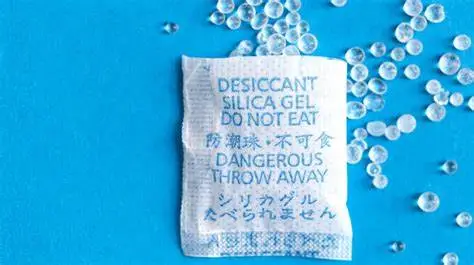
Silica gel can dry flowers by placing them inside an airtight container with a small piece of silica gel. The flower will absorb moisture from the surrounding environment, but because of its outer layer, it will not absorb any water from the silica gel.
It would help to place your flowers inside an airtight container with silica gel before drying them out. It would help if you did not use ordinary plastic bags or glass jars for this purpose because they leak moisture into their surroundings and spoil your flowers.
What Is Silica Gel?
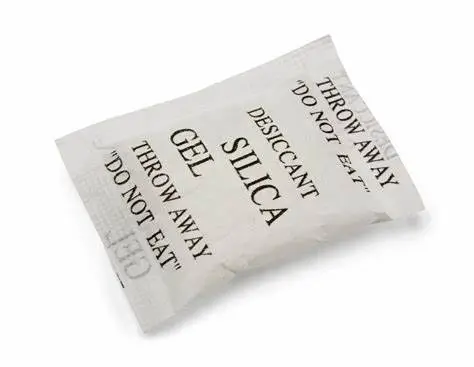
Silica gel is a desiccant that absorbs moisture from the air. It’s used in many products to keep them dry and humidity-free, including:
- Silica gel packets in food packaging
- Silica gel beads in electronic equipment packages.
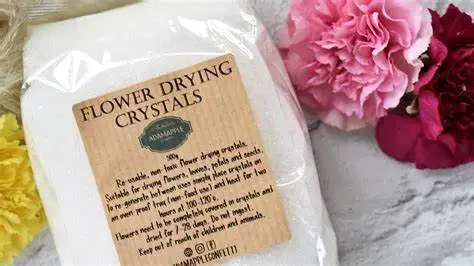
Silica gels are made from silicon dioxide (sand), which is heated to very high temperatures until it becomes a vapor. The vapor is then condensed into a solid block or powder. Depending on its absorbent at different temperatures, you can buy silica gel in different sizes and colors.
How Do You Dry And Preserve Flowers With Silica Gel?
The silica gel is a great way to keep your flowers fresh. It works by absorbing water from the air, so when you put it in a jar with some salt or another substance that attracts moisture, it will suck up water from the flowers and keep them fresh.
- Fill a jar with silica gel balls or beads (these are usually sold at craft stores).
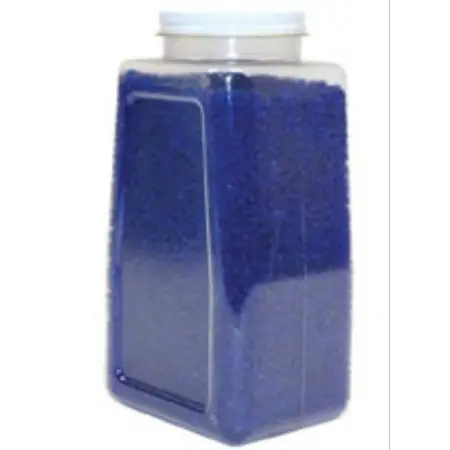
Put salt or another substance that attracts moisture into the jar so the silica gel has something to suck up water from when it gets wet. The salt doesn’t have to be much — just a pinch will do!
- Place your flowers or plants between silica gel balls’ layers and add more until completely covered.
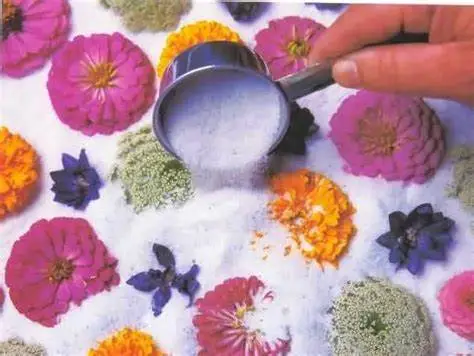
If there aren’t enough holes in your container, you can use small holes made with an ice pick or other sharp object. You may need to trim some of the stems off so that they don’t stick out above the surface of the silica gel ball – use pruning shears if necessary!
- Seal tightly with plastic wrap and put on top of a refrigerator or similar place where there’s plenty of circulation but low humidity (not in direct sunlight).
When storing flowers with silica gel, you’ll need to use more than one packet per flower. Place a couple of packets into a container with an airtight seal (make sure there’s enough space for the flowers to fit in), add your flowers, and close them up tight. Check on them in a few days or weeks (depending on how long you want them to last) and see if they still look good! If not, open up the container and add more silica gel until they look good again (or until they’re completely dried out). |
Use Caution When Working With Silica Gel
Silica gel is a desiccant that absorbs moisture. It’s used to protect products from moisture damage and mold growth. Silica gel can also be used to dry flowers.
Place Flowers In Microwave-Safe Container
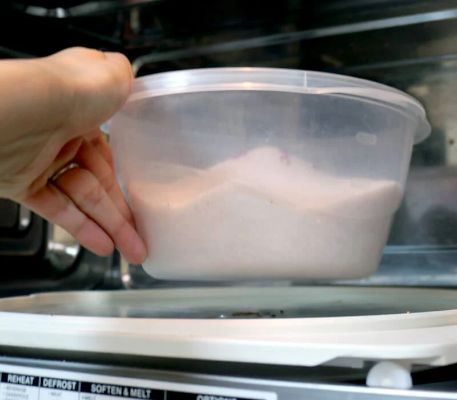
The silica gel must be heat treated to become active. This step will remove residual water from the material and prepare it for use. To heat treat, the silica gel, place it in a microwave-safe container with a lid and cover it with water. Heat on high until boiling stops; let stand 30 minutes, then drain and rinse with distilled water.
To do so, follow these steps:
- Lay your flowers on a flat surface, preferably in a single layer.
- Sprinkle the silica gel over the flowers until fully covered. The more you use, the longer it will take for your flowers to dry, so use only a little of it at first. If you need to add more later, pour more onto the top of your flower arrangement and gently press down with your fingers or a spoon until it is fully covered with silica gel.
- Fill your container with silica gel until it’s about halfway complete, and then add water until only about half of the container remains empty (this will help prevent mold growth). Add your flowers in an even layer on top of the silica gel, making sure not to overcrowd them; if necessary, sprinkle more silica gel over them to cover them up again.
- Place the dried flowers on the silica gel and seal tightly with plastic wrap or foil. Place in an oven set at 90 degrees C (194 degrees F) for about one hour or until dry enough for your satisfaction (the time may vary). Remove from oven and allow flowers to cool before removing from packaging or storage container.
How To Dry Flowers With Silica Gel In The Microwave?
The following method is one of the best ways to dry flowers with silica gel. It’s easy, fast, and efficient.
What You Need:
- Flowers
- Silica gel (a desiccant)
- Small bowl or container (about 1 cup capacity)
- Microwaveable plate or small plate that fits inside the bowl
- Paper towels (2-3)
Steps:
- Place a paper towel on a microwaveable or small plate that fits inside the bowl. Wet it with water and wring it until it’s almost dry but not completely dry. Ensure there isn’t any water left on the towel when you’re done wringing it out! The towel should be damp but not wet or dripping; otherwise, your flowers will get too wet when placed on top.
- Place your flower heads on the dampened paper towel so each head sits on its paper towel. This will prevent them from sticking together while drying out in the microwave later, so make sure they don’t overlap! If your flowers are too big for this method, cut them into smaller pieces so each piece can have its own paper towel to dry.
- Microwave your flower heads for 30 seconds, then remove them from the microwave and check if they’ve started to dry out yet (if not, put them back in for another 30 seconds). If they are still a little wet, continue microwaving them until they’ve dried out completely (this could take up to 5 minutes).
Buying Guide For Silica Gel
Silica gel is a form of desiccant that absorbs moisture. It keeps flowers fresh and dries out excess moisture in containers.
There are several ways you can use silica gel to preserve flowers.
Crystal Silica Gel
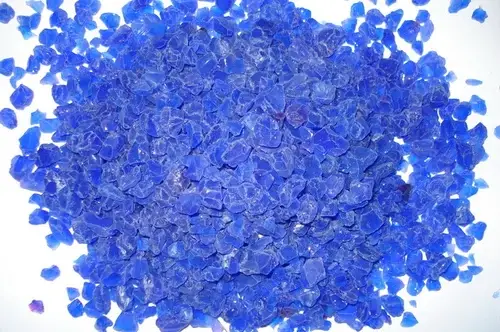
You can buy the crystal form of silica gel at most craft stores and online retailers. When buying this form of the product, look for a variety that says “drinking water safe” on the label; this ensures that it won’t leach any chemicals into your flowers’ water supply.
You can also buy packets of silica gel crystals and use them as is, but you’ll need to ensure that each packet has enough crystals to be effective. Most packets contain about two ounces of silica gel powder, enough for about three pounds of flowers or plants.
Desiccant Packs

If you want a longer-lasting solution, purchase desiccant packs designed to preserve flowers from craft stores or online retailers like Amazon. These packs often include multiple layers of desiccant material inside a pouch, so they’re more effective than plain silica gel crystals alone.
What Flowers Can Be Dried With Silica Gel?
The following flowers work well when dried with silica gel:
- Roses:
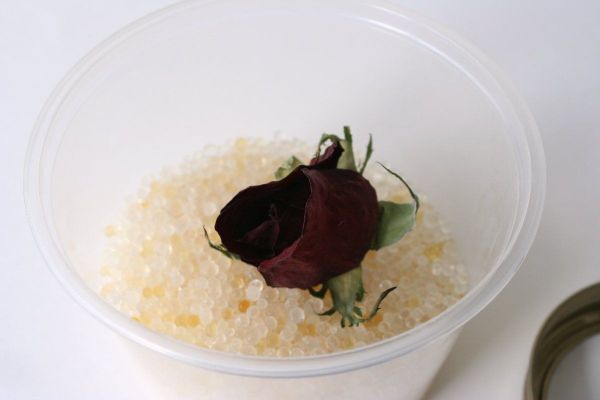
Silica gel is an excellent option for drying roses as it can preserve their shape and color. However, you should use the correct type of silica gel for this purpose. The best way to find out if your rose is preserved well is by looking at its leaves – if they are still green, your rose is not dry enough yet and needs more time in the silica gel.
Lavender:
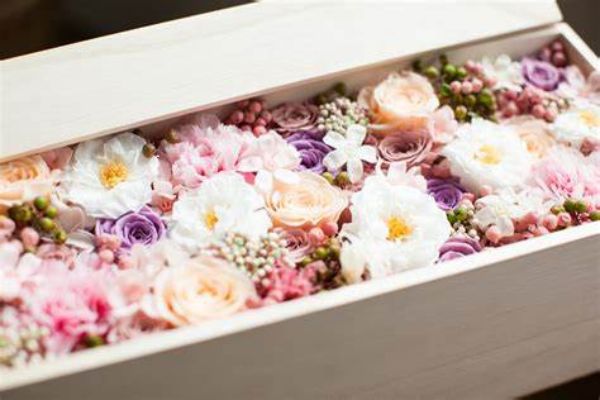
Drying lavender with silica gel helps to retain its fragrance and color.
Delicate blooms:
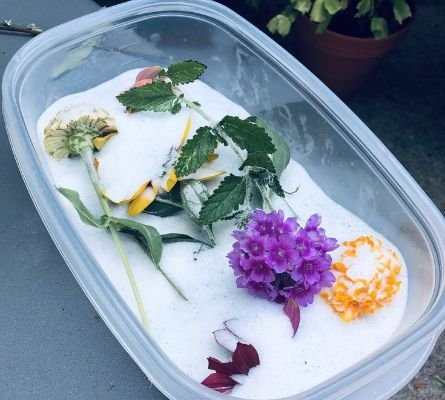
Silica gel is a good choice for drying delicate flowers, such as pansies, daisies, and violets, as it can help prevent the flowers from wilting or losing their color.
- Hydrangeas: Silica gel is a popular choice for drying hydrangeas, as it can help to keep their vibrant colors intact.
- Sunflowers: Silica gel can also dry sunflowers, helping preserve their unique shape and color.
- Carnations: Carnations are among the most popular flowers in dried flower arrangements. Silica gel is a great way to preserve the color and shape of these delicate blooms.
- Orchids: Orchids are another popular dried flower that can be preserved with silica gel. The silica gel will help keep the petals from wilting or turning brown while they dry out.
- Primroses: Primroses are one of the easiest flowers to dry with silica gel, as long as you do not use too much material at once (see below).
- Lilacs: Lilac flowers are easy to dry using silica gel. After placing them on a tray with silica gel crystals, leave them for a few days until all moisture has evaporated from the buds, then put them back into water-soaked paper towels and store them somewhere cool (but not cold).
- Weeds: Drying weeds with silica gel is another easy way to preserve them for future use or display. Place the weed onto a piece of parchment paper and pour some silica gel over it until it covers all parts of the plant. Place this under a heat lamp or in another warm area until the silica gel has absorbed all moisture. When this happens, remove it from its drying location and store it somewhere cool and dark until you’re ready to use it again!
- Daffodils: Drying daffodils with silica gel will help keep their color and shape.
- Daisies: Use silica gel to dry daisies so the colors stay bright.
- Gardenias: Gardenias are beautiful flowers that are easy to dry using silica gel. The process only takes about a week, but you’ll want to ensure your gardenia is completely dry before placing it in an arrangement, as humidity can damage it later.
- Herbs: Dried herbs are used for cooking, so the goal of preserving them is to keep their flavor and aroma intact. Silica gel does just that by absorbing excess moisture from herbs, which prevents them from getting moldy or musty.
- Leather: Leather is made from animal hides, so preserving its structure and preventing it from cracking over time is essential. Drying leather with silica gel allows you to store it without damaging its texture or appearance.
How Do You Know When Flowers Are Done Drying In Silica Gel?
The drying process can take 24 hours to a week or more, depending on the flower type and how many times you’ve flipped your flowers. Breaking off a stem is the best way to tell if your flowers are dry. If it snaps quickly, it’s dry enough to be stored in an airtight container or bag. If it bends, give it another day or two of drying time.
Add another pack if you need more airflow through silica gel packs. This will allow more moisture to escape and speed up the drying process.
Be sure to check back on your flowers every few days while they’re drying in silica gel packs because they can begin to mold if left too long!
Can You Leave Flowers In Silica Gel For Too Long?
If you leave your flowers in silica gel for too long, they may become brittle and break. If you dry tiny flowers or leave them in the silica gel too long, this can happen. If this happens, don’t worry! You can still use them in arrangements or decorations. And if you find yourself with many broken flowers, we have some great tips on fixing them here!
How Is Removing Flowers From The Silica Gel?
After the flowers have been left in the silica gel for the recommended time and are thoroughly dried, it’s time to remove them from the silica gel. Here are the steps to remove flowers from silica gel:
- Carefully uncover the container or the bag containing the silica gel and the flowers.
- Gently brush off any excess silica gel from the flowers with a soft-bristled brush or a dry paintbrush.
- Use a pair of tweezers or a gentle touch to remove the flowers from the silica gel. Be careful not to pull too hard on the flowers, as they may be brittle and delicate after drying.
- If some silica gel is still stuck to the flowers, you can use a fine-mesh sieve to sift the flowers and remove any remaining silica gel gently.
- Once the flowers are silica gel-free, you can arrange them in a vase or use them for various craft projects.
How Do Dry Flowers Without Silica Gel?
If you do not have any silica gel packets on hand or are too expensive for your budget, then there are other ways to dry your flowers without using this product. Here are some tips for drying your flowers without using silica gel:
Use newspaper
Newspaper helps wick away moisture from within a flower arrangement and allows them to dry quicker than if left alone without human intervention. This works exceptionally well for arrangements that contain more delicate blooms, such as roses or lilies, because these plants tend to be more susceptible to mold and mildew. Place the paper in between each layer of flowers so that it can absorb all of the excess moisture before it has a chance to ruin your arrangement.
Use ice cubes
If you want to eliminate excess moisture from within an arrangement, place some ice cubes into a plastic bag and freeze them solid. Once they are frozen solid, place them into the bottom of the vase with your flowers inside. This will help lower the temperature inside of the vase and will make it easier for water droplets to evaporate off of each bloom as well as from within the entire arrangement at once.
Put the flowers in a cool, dry place
If you have an empty room or closet, then use it to hang up your flower arrangements so that they will have plenty of space to hang freely and allow air to circulate them. Another option would be to use a cardboard box filled with crumpled-up newspaper. Use a paper bag instead of a newspaper to avoid too much mess in your home afterward. Ensure the plastic container is sealed tightly before storing it so that moisture does not leak out over time due to evaporation.
Drying flowers in salt
It’s another method of preserving blooms. Salt is a natural desiccant that draws moisture from flowers, making it an excellent alternative to silica gel. Here’s how to dry flowers using salt:
- Choose the flowers you want to dry. Salt works best with flowers that have thick, fleshy petals, like roses, zinnias, and chrysanthemums.
- Prepare a container filled with salt. You can use any salt, including table salt or kosher salt. Pour enough salt to cover the bottom of the container.
- Cut the stems of the flowers to the desired length and remove any leaves. Arrange the flowers on top of the salt, ensuring they don’t touch each other.
- Cover the flowers entirely with salt. Gently pour salt around the flowers, making sure to cover them entirely.
- Leave the flowers to dry for several days to several weeks, depending on the size and type of flower. Once the flowers are dehydrated, gently remove them from the salt, brushing off any excess salt with a soft-bristled brush.
- If the flowers are still moist after several days, replace the salt with fresh salt to ensure that the flowers dry completely.
FAQs
Can I Reuse Silica Gel?
Yes, you can reuse it. Just ensure any moisture or other substance does not contaminate the gel. The best way to do this is to soak the gel in water before using it again.
How Long Do Flowers Last After Drying In Silica Gel?
The time that flowers last after drying depends on how long they were preserved before drying and how well you take care of them afterward. The longer they were preserved, the longer they would last after drying.
How Do You Recharge Silica Gel?
Silica gel can be recharged in an oven at 250 degrees Fahrenheit for about 30 minutes. Once it cools down, the silica gel should regain its original moisture-absorbing properties.
Can Bacteria Grow In Silica Gel?
Silica gel is highly absorbent and does not promote bacterial growth like most other desiccants. However, if you leave it out for too long, it may get moldy from the moisture being trapped by the gel.
Can I Dry Silica Gel In The Sun?
It is not recommended to dry silica gel in the sun. Silica gel is a type of desiccant used to absorb moisture and is commonly used for drying flowers, electronics, and other sensitive items. While it may be tempting to dry silica gel in the sun to speed up the drying process, it can harm the silica gel and make it less effective.
Exposure to direct sunlight can cause the silica gel to break down and lose its ability to absorb moisture effectively. This can be especially problematic if you use silica gel to protect valuable or sensitive items like electronics. It may be less effective at keeping them dry and preventing damage.
Instead of drying silica gel in the sun, it is best to follow the manufacturer’s instructions on how to dry it properly. Typically, this involves heating the silica gel in an oven or microwave to remove any moisture that it has absorbed. Be careful when heating silica gel, as it can get very hot and potentially cause burns or start a fire. Always follow the manufacturer’s instructions carefully and take proper safety precautions when handling and heating silica gel.
Should You Touch Silica Gel?
It’s not recommended that you touch silica gel because it can cause skin irritation and other health problems if you come into contact with it for long periods or if there’s enough of it on your hands for some time after touching it initially. It’s best to wear gloves when handling silica gel until you’ve finished using it for drying purposes.
What Colour Does Silica Gel Go After Moisture?
Here are the most common color changes in silica gel after it absorbs moisture:
- Blue or pink: Silica gel packets often contain a moisture indicator that changes color when the silica gel absorbs moisture. The most common colors are blue or pink. Silica gel will turn blue or pink when it reaches maximum moisture absorption capacity.
- White: When silica gel absorbs moisture, it may also turn white. This color change indicates that the silica gel has absorbed significant moisture but has yet to reach its maximum capacity.
- Green: Sometimes, silica gel may turn green after absorbing moisture. This color change indicates that the silica gel has absorbed moderate moisture but has yet to fully saturated.
Does Silica Gel Preserve Flowers Forever?
Silica gel can be an effective method for preserving flowers, but it does not preserve them forever. Over time, even with proper preservation, flowers may fade or deteriorate, depending on the type of flower and the conditions in which they are stored.
When using silica gel to preserve flowers, the goal is to remove as much moisture as possible from the flowers, which helps to prevent decay and discoloration. Properly dried and stored flowers preserved with silica gel can last for several months to a few years, depending on the type of flower and the conditions in which they are stored.
However, even dried and preserved flowers can begin to fade or show signs of decay over time. Exposure to light, moisture, and other environmental factors can also affect the lifespan of preserved flowers.
While silica gel can effectively preserve flowers, it’s essential to remember that it does not preserve them forever. To maximize the lifespan of preserved flowers, it’s essential to store them properly in a dry, cool, and dark place and avoid exposing them to moisture or direct sunlight.
